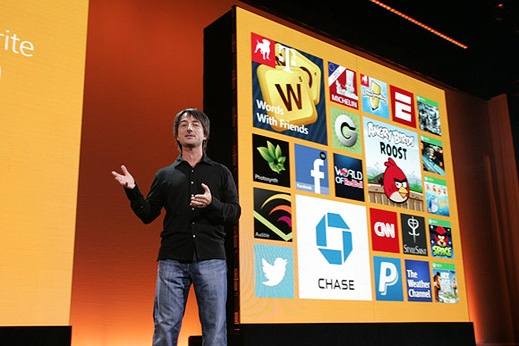
New tricks: Joe Belfiore, manager of the Windows Phone Program at Microsoft, at the launch of Windows Phone 8 in October.
On a rainy day last week, the scene at Microsoft’s Mountain View, California, campus looked rather incongruous: several dozen developers sat in an auditorium, many of them taking notes on Apple laptops, while another programmer, also using a Mac, stood behind a podium flanked with Microsoft’s blocky logo.
This wasn’t a secret meeting of Microsoft rebels, however; it was actually Microsoft’s attempt to lure developers who have been building apps for Apple’s incredibly popular iOS platform, which runs on the iPad and iPhone, over to its Windows 8 and Windows Phone platforms.
In years past, Microsoft had the majority of developer attention on its Windows software—programmers would write software for Windows first. Apple’s Macs were often an afterthought. But with the rise of the iPhone and iPad and mobile computing in general, not to mention Google’s Android OS, things have changed. Now, with many developers building apps for Apple’s gadgets and smartphones and tablets running Android software, the Redmond, Washington-based software giant finds itself in the unfamiliar position of needing to get developers’ attention.
That was clearly the goal back in Mountain View. Behind the podium hung several screens showing the bright, tile-filled home-screen that is a hallmark of Microsoft’s new Windows 8 and Windows Phone 8 software—squares and rectangles that update automatically to show you the latest updates and alerts from various apps. Onstage, a developer answered questions such as whether you can put a button on a tile that users can press (answer: no) and what the best color is to use for your app’s tile (answer: strong, bright colors; unlike iOS, no gradients are allowed).
The session was one of many held over two days at Microsoft’s campus to give iOS developers of all types a better grasp of how to make apps for its Windows Store, which offers apps for the latest Windows tablets and PCs (Windows Phone 8 was discussed too, but the focus was mostly on building apps for computers and tablets).
Such efforts make sense, says Carl Howe, vice president of data science research at Yankee Group. Many iOS developers already have successful apps in Apple’s App Store, so for many of them, it may just be a matter of bringing these apps over to Microsoft’s storefront.
And for iOS developers that attended the event, Microsoft’s overtures seemed to be working, partly because of Microsoft’s traditional focus on supporting developers. Tim Burks, founder of iOS app development and consulting company Radtastical and an organizer of the Silicon Valley iOS Developers’ Meetup group, says writing apps for another platform can be hard because you need to change your mind-set. Microsoft’s instructional overtures make considering its platform “a high priority,” he says. Burks is drawn to Microsoft’s developer tools, which he sees as stable, predictable, and well-documented—all things he believes will make it possible to build great apps.
“If you’re a professional dancer, would you want to dance on a stage with broken boards and holes on the floor?” he asks. “No, you want to dance on a stage that’s clean and organized. That’s what these guys—especially Apple, and it looks like Microsoft—are like.”
Those in attendance were also drawn to the looks of Microsoft’s latest releases. While Apple has a long-term commitment to skeuomorphic design—making on-screen buttons and bookshelves look nearly real enough to touch—developers at the event expressed admiration for the crisp, uncluttered look of Windows 8 and Windows Phone 8.
Burks praised the “visual cleanness” of the software. Likewise, Sol Tran, a novice programmer working for a startup that has built a location-discovery app for the iPhone, says Microsoft’s embrace of a simpler look helps users focus on the content.
There are concerns, however. While Apple’s iOS is the operating software for the Cupertino, California, company’s tablets and smartphones, its computers get their own OS. But Microsoft is keeping its laptop and desktop computers and tablets on the same operating system (Windows RT, a version of Windows 8 built for ARM chips, runs on tablets like Microsoft’s Surface), while smartphones get their own software. This can make things a bit confusing, says Todd Barker, whose company, Cannae Global Systems, is building several entertainment apps for iOS and hopes to roll them out on multiple platforms.
Howe says having several different Windows platforms to program for is “a bit of a nightmare” for software makers, who have to decide what they’re designing for and if they think the revenue it will produce will make it worth their while.
Yet several iOS developers, including Santhosh Krishna, an Oracle developer who builds children’s learning apps for iOS in his spare time, say they are interested in developing for Windows-running tablets and smartphones precisely because the market isn’t as crowded as Apple’s App Store.
Microsoft’s Windows Phone Store has over 120,000 apps, and the company hassaid it expects to have 100,000-plus apps in the Windows Store by January. Apple’s App Store, by comparison, offers over 700,000 apps for the iPhone and iPad.
“It’s a lot easier to get lost in iOS world because there are a million apps out there,” Krishna says.


No comments:
Post a Comment